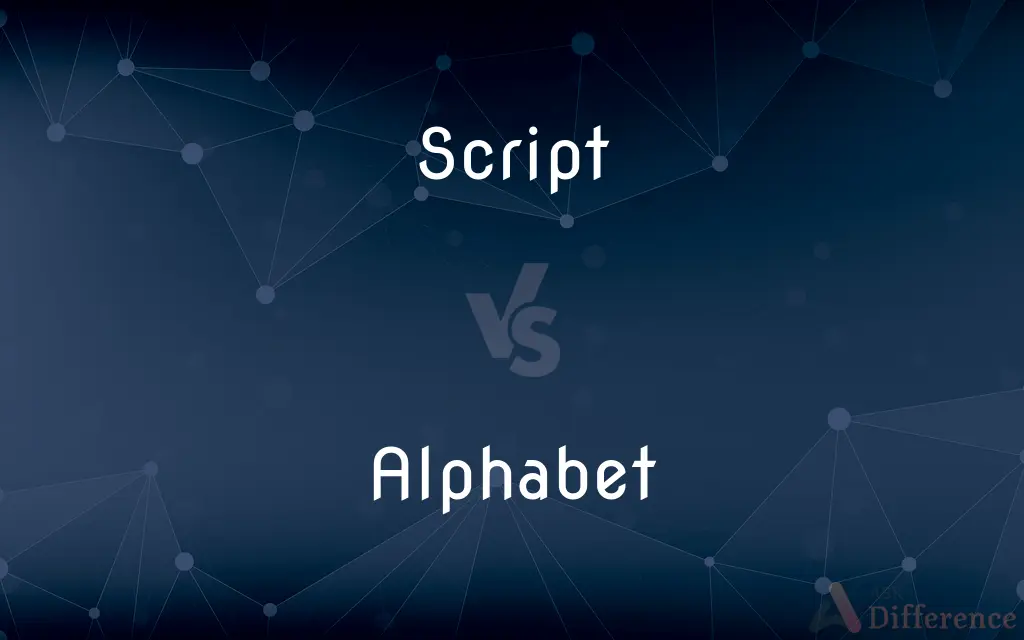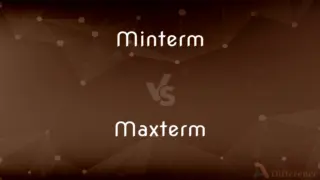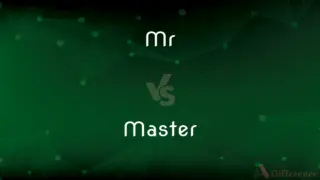Script vs. Alphabet — What's the Difference?
Edited by Tayyaba Rehman — By Maham Liaqat — Updated on April 24, 2024
Script is a system of written characters representing words or sounds in a language, while an alphabet is a specific type of script consisting of letters that each typically represents one phoneme.

Difference Between Script and Alphabet
Table of Contents
ADVERTISEMENT
Key Differences
A script encompasses various systems used to write languages, employing symbols to represent elements like sounds, words, or ideas. For example, Chinese characters represent words or morphemes. On the other hand, an alphabet specifically uses a set of letters where each symbol generally corresponds to a single phoneme or basic sound. This is seen in languages like English or Spanish.
Scripts can vary from logographies to syllabaries and alphabets, depending on how they encode linguistic information. For instance, a logographic script, like Chinese, uses characters to represent words or meanings. Whereas alphabets represent individual sounds, allowing for a more direct phonetic transcription of spoken language.
The complexity and learning curve of a script can differ significantly. Alphabets tend to have a limited number of characters, making them easier to learn. For example, the English alphabet has 26 letters. In contrast, a logographic script like Chinese requires memorizing thousands of characters.
Usage and geographical distribution of scripts vary widely. Alphabets are commonly used across many parts of the world and are foundational in languages like English, Russian, and Arabic. In contrast, specific scripts such as Devanagari or Kanji are regionally concentrated in India and Japan, respectively.
The adaptability of scripts to technology also shows variance. Alphabets, with fewer characters, adapt more readily to keyboards and digital interfaces. Scripts with large sets of characters, such as Chinese, have required more complex solutions for digital input.
ADVERTISEMENT
Comparison Chart
Definition
A system of symbols for writing.
A script with letters for phonemes.
Examples
Chinese, Devanagari, Cyrillic.
Latin, Greek, Cyrillic.
Symbol Representation
Can represent sounds, words, or ideas.
Represents individual sounds.
Learning Curve
Can be high for logographic scripts.
Generally lower due to fewer characters.
Adaptability
Varied, often complex for digital use.
Easier adaptation to digital formats.
Compare with Definitions
Script
A method of writing languages.
The Devanagari script is used to write several languages of India.
Alphabet
A set of letters used to represent the phonemes of a language.
The English alphabet consists of 26 letters.
Script
A set of visual symbols used systematically.
Egyptian hieroglyphs are an ancient script with complex symbols.
Alphabet
Typically fewer characters than other script types.
The Greek alphabet has 24 letters.
Script
Can be alphabetic, syllabic, or logographic.
Japanese employs both syllabic and logographic scripts.
Alphabet
Used widely across the world in many languages.
The Cyrillic alphabet is used in Russian and other Slavic languages.
Script
May involve a large or small set of characters.
The Chinese script has thousands of characters.
Alphabet
Directly corresponds to spoken sounds.
Each letter in an alphabet usually represents a distinct sound.
Script
Used across various media and technologies.
Modern scripts are adapted for use in both print and digital forms.
Alphabet
Facilitates easier learning and literacy.
Alphabetic literacy rates tend to be higher globally.
Script
Handwriting.
Alphabet
An alphabet is a standardized set of basic written symbols or graphemes (called letters) that represent the phonemes of certain spoken languages. Not all writing systems represent language in this way; in a syllabary, each character represents a syllable, for instance, and logographic systems use characters to represent words, morphemes, or other semantic units.The first fully phonemic script, the Proto-Canaanite script, later known as the Phoenician alphabet, is considered to be the first alphabet, and is the ancestor of most modern alphabets, including Arabic, Cyrillic, Greek, Hebrew, Latin, and possibly Brahmic.
Script
A style of writing with cursive characters.
Alphabet
The letters of a language, arranged in the order fixed by custom.
Script
A particular system of writing
Cuneiform script.
Alphabet
A system of characters or symbols representing sounds or things.
Script
A style of type that imitates handwriting.
Alphabet
A set of basic parts or elements
"genetic markers ... that contain repeated sequences of the DNA alphabet"(Sandra Blakeslee).
Script
The matter set in this type.
Alphabet
The set of letters used when writing in a language.
The Greek alphabet has only twenty-four letters.
In the first year of school, pupils are taught to recite the alphabet.
Script
The text of a play, broadcast, or movie.
Alphabet
A writing system in which letters represent phonemes. Contrast e.g. logography, a writing system in which each character represents a word, and syllabary, in which each character represents a syllable.
Script
A copy of a text used by a director or performer.
Alphabet
A writing system in which there are letters for the consonant and vowel phonemes. Contrast e.g. abjad.
Script
(Law) The original of a legal instrument, as opposed to a copy.
Alphabet
(computer science) A typically finite set of distinguishable symbols.
Let be a regular language over the alphabet .
Script
(Computers) A simple program in a language that the computer must convert to machine language each time the program is run.
Alphabet
An individual letter of an alphabet; an alphabetic character.
Script
To prepare (a text) for filming or broadcasting.
Alphabet
The simplest rudiments; elements.
Script
To arrange, direct, or control (an event or a person) as if supplying a script
"the brilliant, charming, judicial moderate scripted by his White House fans" (Ellen Goodman).
Alphabet
An agent of the FBI, the CIA, or another such government agency.
Script
(Computers) To write (code) for a program.
Alphabet
(rare) To designate by the letters of the alphabet; to arrange alphabetically.
Script
A writing; a written document.
Alphabet
The letters of a language arranged in the customary order; the series of letters or signs which form the elements of written language.
Script
Written characters; style of writing.
Alphabet
The simplest rudiments; elements.
The very alphabet of our law.
Script
(typography) Type made in imitation of handwriting.
Alphabet
To designate by the letters of the alphabet; to arrange alphabetically.
Script
An original instrument or document.
Alphabet
A character set that includes letters and is used to write a language
Script
(countable) The written document containing the dialogue and action for a drama; the text of a stage play, movie, or other performance. Especially, the final form used for the performance itself.
Alphabet
The elementary stages of any subject (usually plural);
He mastered only the rudiments of geometry
Script
(computing) A file containing a list of user commands, allowing them to be invoked once to execute in sequence.
Script
(psychology) A behavioral script; sequence of actions in a given situation.
Script
(linguistics) A system of writing adapted to a particular language or set of languages.
Script
(informal) prescription for drugs or medicine
Script
(transitive) To make or write a script.
Script
(transitive) To devise, concoct, or contrive.
Script
A writing; a written document.
Script
Type made in imitation of handwriting.
Script
An original instrument or document.
Script
Written characters; style of writing.
Script
A written version of a play or other dramatic composition; used in preparing for a performance
Script
Something written by hand;
She recognized his handwriting
His hand was illegible
Script
A particular orthography or writing system
Script
Write a script for;
The playwright scripted the movie
Common Curiosities
How does an alphabet differ from other scripts?
An alphabet is a script where each letter typically represents one phoneme, making it more directly phonetic.
Why are alphabets considered easier to learn?
Alphabets usually have fewer characters and a direct one-to-one correspondence between letters and sounds.
Are scripts tied to specific languages?
Some scripts are used for multiple languages, while others are specific to a single language.
Do all languages use an alphabet?
No, many languages use other types of scripts such as syllabaries or logographies.
Can a script include alphabets?
Yes, an alphabet is a type of script specifically designed to represent the phonemic structure of a language.
How do scripts evolve?
Scripts evolve through changes in technology, culture, and interaction with other languages.
What is a script in writing?
A script is a system of symbols used to represent elements of a language such as sounds, words, or phrases.
What makes a script adaptable to digital technology?
Scripts with fewer characters and simpler structures, like alphabets, are easier to adapt to digital platforms.
What is the most complex script?
Scripts like Chinese, which require knowledge of thousands of characters, are among the most complex.
Is the English writing system purely alphabetic?
English uses an alphabet, but spelling can be complex due to historical influences and phonetic changes.
What role do scripts play in cultural identity?
Scripts are a key part of cultural identity and heritage, reflecting the history and evolution of their communities.
Can one language use multiple scripts?
Yes, for example, Serbian can be written in both Cyrillic and Latin alphabets, depending on the context.
Can scripts influence literacy rates?
Yes, scripts that are simpler and more phonetic, like alphabets, generally support higher literacy rates.
What are examples of non-alphabetic scripts?
Examples include the Chinese characters (a logographic script) and the Japanese kana (a syllabic script).
How many alphabets are there in the world?
There are several dozen alphabets, including variations and historical forms.
Share Your Discovery

Previous Comparison
Minterm vs. Maxterm
Next Comparison
Mr vs. MasterAuthor Spotlight
Written by
Maham LiaqatEdited by
Tayyaba RehmanTayyaba Rehman is a distinguished writer, currently serving as a primary contributor to askdifference.com. As a researcher in semantics and etymology, Tayyaba's passion for the complexity of languages and their distinctions has found a perfect home on the platform. Tayyaba delves into the intricacies of language, distinguishing between commonly confused words and phrases, thereby providing clarity for readers worldwide.














































